 February 6, 2025
February 6, 2025How Do You Run a Safety-Net Hospital During a HiringFreeze?
 February 6, 2025
February 6, 2025
How Do You Run a Safety-Net Hospital During a HiringFreeze?
Mayor Lurie Freezes Laguna Honda Hospital’s Hiring
Punished With Hiring Freeze, Laguna Honda Hospital Victimized by
Decades-Long Mayoral Hiring Binge of Senior Managers Citywide
by Patrick Monette-Shaw
San Franciscans belatedly learned Mayor Lurie imposed a hiring freeze — apparently to close an $800 million plus budget deficit he’s facing — when the Health Commission’s Laguna Honda Hospital Joint Conference Committee (LHH-JCC) met on Monday, February 3.
It’s thought all of LHH’s current 85.5 vacant positions have been frozen, however temporarily. A separate “Vacancy Report with Notes by Job Code” background file presented to the LHH-JCC posted on-line shows LHH has a minimum of 49 vacancies across 36 separate job classification codes that are frozen, including five Activity Therapists, one Activity Therapy Supervisor, one Clinical Neuropsychologist, one Clinical Psychologist, one Senior Psychiatric Physician, one Senior Occupational Therapist, and two Physical Therapist positions — all listed as “positions frozen” and all of which provide direct patient care. Why are direct patient care positions frozen?
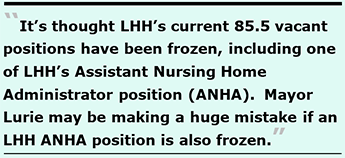 The 49 vacancies were listed because they exceed the 10% threshold for inclusion on the report. More likely, all 85.5 vacancies are probably frozen, including jobs that are ancillary, non-clinical staff necessary to run a hospital as large as LHH.
The 49 vacancies were listed because they exceed the 10% threshold for inclusion on the report. More likely, all 85.5 vacancies are probably frozen, including jobs that are ancillary, non-clinical staff necessary to run a hospital as large as LHH.
Additionally, the report includes one “Manager VI” — presumably LHH’s Assistant Nursing Home Administrator (ANHA) position vacated by Diltar Sidhu, when he was promoted to being LHH’s CEO and Nursing Home Administrator (NHA). Lurie may be making a huge mistake if LHH’s ANHA position is also frozen, because the Centers for Medicare and Medicaid Services (CMS) had essentially ordered LHH hire a NHA and two AHNA’s as a precondition to ending LHH’s 26-month decertification and a condition for obtaining re-licensure.
Unfortunately, we don’t know yet whether additional direct patient care vacancies — including 17 Certified Nursing Assistants, 8 Licensed Vocational Nurses, 5 Registered Nurses, one Nurse Manager, and one Senior Physician Specialist — among other vacancies, are also frozen, because their vacancy rates are all below 10%.
Will we find out those positions are also “frozen” only when they pass the 10% threshold? Or will we find that out, only after LHH receives more “Immediate Jeopardy” citation from CMS threatening LHH’s license, all over again?
 When hiring is frozen, it typically makes patient care worse off. How do you run a hospital when these direct patient care clinical staff positions are frozen, prevented from hiring — however temporarily — just to solve a City budget deficit?
When hiring is frozen, it typically makes patient care worse off. How do you run a hospital when these direct patient care clinical staff positions are frozen, prevented from hiring — however temporarily — just to solve a City budget deficit?
What’s Lurie thinking? Is Lurie angling to get LHH decertified for the second time? Why isn’t the Health Commission standing up to the Mayor in the bully pulpit, and forcefully telling him he can’t continue adversely affecting and compromising direct patient care?
Lurie should instead be retroactively cutting massive “management fat” that has sprung up in every City department.
Mechanics of Lurie’s Hiring Freeze
The Westside Observer learned that Mayor Lurie’s Office implemented the hiring freeze on Wednesday, January 9, cancelling all City employee position hiring requests previously approved, which now may not be filled unless re-approved by the Mayor’s Office. That’s a good start.
News sometimes travels slowly in San Francisco City government.
Admirably, Maylor Lurie wants to address the City’s structural fiscal deficit, while ensuring the City provides excellent service to San Franciscans, and apparently to our tourist industry that the City relies on so heavily for revenue.
Going forward, all positions will require the Mayor’s Budget Office review and approval. The hiring freeze instructions to City Department Heads outline how the process works going forward.
The Mayor’s four new Policy Chiefs and Mayor’s Budget Office will review requests for exemptions to the hiring freeze once per month. City Departments were instructed to prioritize and submit all positions each department would like approved for the next two months by Friday, January 31. The prioritized requests will be reviewed and decided upon during the first two weeks of February. The next time Departments can request additional approvals to fill positions will be February 28. Thereafter, requests for exemptions to the hiring freeze will be reviewed once per month.
While this represents a good start, Mayor Lurie’s team needs to retroactively review and begin eliminating the bloat in City employee hiring — starting with the glut of senior manager hiring — that has occurred since Fiscal Year 2010–2011 that began on July 1, 2010.
City Employee Hiring Spree
The total number of City employees added to the City’s payroll since FY 10–11 has mushroomed by 8,605 (to a total of 42,584 full and part-time employees) excluding San Francisco Superior Court employees, per the City Controller’s annual payroll databases — at an increased cost of $2.4 billion, which payroll totaled $4.88 billion as of June 30, 2024 (nearly doubling since July 2010 and representing a 95% change increase). The City likes to claim it has approximately 34,000 employees, which the City creatively claims are so-called “full-time equivalents” (FTE’s). One employee working 40 hours weekly for 52 weeks equals 2,080 hours, deemed to be a 1.0 FTE.
But there were actually 42,584 named employees on the payroll as of June 30, 2024, including some named employees who work in two different job classification codes. Converting the total “regular pay” hours worked by the 42,584 employees to “full-time equivalents” yields 32,786 FTE’s. But adding in the total “overtime pay” hours worked by the 42,584 named employees yields an additional 2,352 FTE’s, bringing the total FTE’s to 35,138 FTE’s, not 34,000 the City likes to claim.
Lurie should consider a retroactive review, and scale back, or “claw back,” the glut of City employees hired since Fiscal Year 2010–2011 in specific areas.
 Lurie Should “Claw Back” City Employee Bloat
Lurie Should “Claw Back” City Employee Bloat
Mayor Lurie and his budget team need to take a serious look at the increased bloat in City hiring under that occurred under Mayor Ed Lee’s and Mayor London Breed’s watch, particularly starting in Fiscal Year 2010–2011 that started on July 1, 2010. Then begin rapidly eliminating that bloat.
City Controller payroll database records show San Francisco had 33,979 employees on the City payroll in FY 10–11, which grew to 42,584 employees at the end of FY 23–24 (ending June 30, 2024), an increase of 8,605 employees representing a 25.3% change increase. Their combined total pay (excluding fringe benefits skyrocketed) by 94.8%, from $2.5 billion to $4.9 billion, a whopping $2.4 billion increase.
A granular analysis of the payroll database records shown in Table 1 suggest nine areas of interest that Mayor Lurie should consider scaling back, imposing “claw backs” to reduce the size of City government. Clearly imposing a hiring freeze going forward will not solve the root cause of the increased bloat.
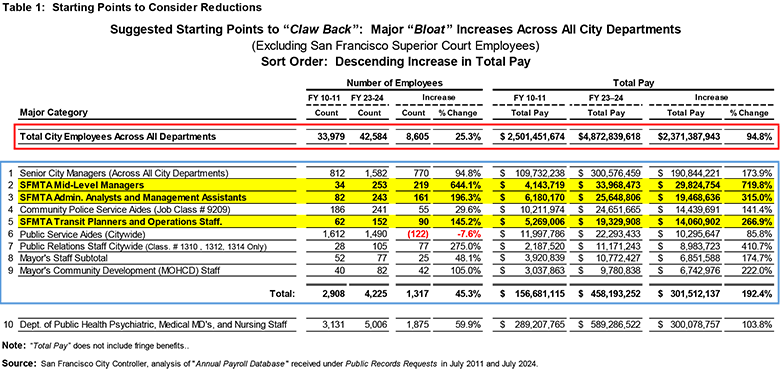
The nine areas include increases to staff in the Mayor’s Office, massive increases in senior city managers across all City departments,, public relations (PR) staff across all City departments, “public service aides” citywide, community police service aides, and three areas within SFMTA: mid-level MTA managers, MTA administrative analysts and management assistants,” and MTA transit planners and operations staff.
Of note, the three SFMTA subcategories include an additional 470 employees (a 264% change increase), at an increased payroll cost of $301.5 million (excluding fringe benefits) — representing a staggering 406.3% change increase!
Those initial nine areas involve an increase of 1,317 additional employees (a 45.3% change increase), at an increased payroll cost of $301.5 million (excluding fringe benefits) — a whopping 192.4% change increase!
Table 1 also shows a separate Department of Public Health category of additional 1,875 psychiatric staff, medical MD’s, and nursing staff, at an increased cost of another $300 million, representing a 103.8% change increase in payroll. That category may also be worth Mayor Lurie’s budget staff review, given that it is completely separate from SFDPH’s external non-profit sector contracting for similar external staff and service provision.
Specifics about the nine main categories follow.
Citywide Senior Manager Bloat
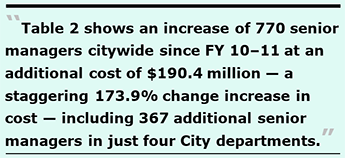 Table 2 shows the increase in Senior Managers by job classification code number between FY10–11 to FY 23–24, with an increase of 770 senior managers (a 94.8% change increase) from 812 senior managers in FY 10–11 to 1,582 in FY 23–24 at an additional cost of $190.4 million (excluding fringe benefits), again for a staggering 173.9% change increase.
Table 2 shows the increase in Senior Managers by job classification code number between FY10–11 to FY 23–24, with an increase of 770 senior managers (a 94.8% change increase) from 812 senior managers in FY 10–11 to 1,582 in FY 23–24 at an additional cost of $190.4 million (excluding fringe benefits), again for a staggering 173.9% change increase.
What has changed over the 14 fiscal years that necessitated having to hire another 770 senior managers to run essentially the same number of City departments? And why are there eight additional job classification code for senior managers that are new since FY 10–11?
Table 3 shows the increase of the 770 additional Senior Managers among the 56 City departments. Table 4 is an extract from Table 3, showing the increase in Senior Managers in the top 14 City Departments. Of note, the 14 top Departments account for 647 (84%) of the additional 770 City managers, at an increase of $157.2 million (82.3%) of the $190.8 million total pay increase.
Four of the 14 departments shown in Table 4 include:
Combined, the four departments added a total of 367 additional senior managers at an increased cost of $88. 5 million. What essential job functions had changed at those four City departments so much since FY 10–11 to justify the need for so many more senior City managers?
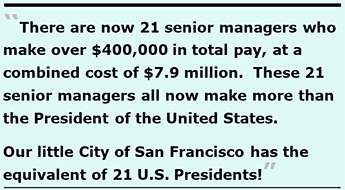 Of note of only the Senior Manager job classification codes listed in Table 2, there are now 21 senior managers who make over $400,000 in total pay (excluding fringe benefits) at a combined cost of $7.9 million, compared to none in FY 10–11. These 21 senior managers all now make more than the President of the United States, whose salary is currently capped at $400,000. That’s like our little City of San Francisco having the equivalent of 21 U.S. Presidents!
Of note of only the Senior Manager job classification codes listed in Table 2, there are now 21 senior managers who make over $400,000 in total pay (excluding fringe benefits) at a combined cost of $7.9 million, compared to none in FY 10–11. These 21 senior managers all now make more than the President of the United States, whose salary is currently capped at $400,000. That’s like our little City of San Francisco having the equivalent of 21 U.S. Presidents!
Also by comparison, in FY 10–11, San Francisco had just one senior City manager paid over $300,000. But as of June 30, 2024 the City now has 72 senior managers paid over $300,000 at a combined cost of $24 million.
And of interest, across all job classification codes (not just senior managers), in FY 10–11 the City had just 5 employees who made more than $300,000 in total pay (excluding fringe benefits), compared to the now 996 City employees who earned more than $300,000 in total pay, at an eye-popping $357.4 million in FY 23–24, ending June 30, 2024.
No wonder Mayor Lurie is facing an $800 million budget deficit!
Are all these 996 employees paid over $300,000 annually political patronage hires, or is it just the senior city managers who are the political patronage hires?
Municipal Transportation Agency Bloat
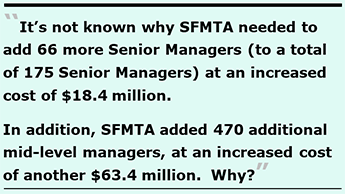 Table 5 primarily shows the increase of mid-level management at SFMTA between FY 10–11 and FY 23–24. At the top of Table 5 is a breakout by job classification code of the now 175 Senior Managers at SFMTA included previously in Table 3 (Senior Managers by City Department.) They’re repeated in Table 5 (but not double-counted in the number of total Senior Managers headcount and costs included in Table 1) for convenience.
Table 5 primarily shows the increase of mid-level management at SFMTA between FY 10–11 and FY 23–24. At the top of Table 5 is a breakout by job classification code of the now 175 Senior Managers at SFMTA included previously in Table 3 (Senior Managers by City Department.) They’re repeated in Table 5 (but not double-counted in the number of total Senior Managers headcount and costs included in Table 1) for convenience.
They’re broken out by job classification code to examine why SFMTA needed to add 66 more Senior Managers Managers at an increased cost of $18.4 million, including 35 additional Manager II’s and 21 more Manager IV’s.
The main purpose of Table 5 is to focus on the 470 additional mid-level managers, transit planners, Operations staff, administrative analysts, and management assistants, at an increased cost of $63.4 million. The addition of the 470 mid-level employees is a 264% change increase (from 178 to 648). The increased $63.4 million cost (from $15.6 million to now $79 million) represents a massive 406.3% change increase. Why were so many mid-level MTA employees added?
The 470 greatly exceed the increase of just 325 additional Transit Operators and bus drivers!
Knowledgeable insiders at SFMTA believe many of the SFMTA’s mid-level staff hiring binge were appointed under patronage hiring by MTA’s former General Manager Jeffrey Tumlin, Julie Kirschbaum (who rose through the ranks from being a Transit Planner V in FY 10–11 to now being a Deputy Director II), and by Leda Rozier (a Senior Personnel Analyst in FY 10–11 promoted to being a Manager VI currently)!
A vast number of current MTA employees believe Ms. Kirschbaum is not qualified to be the Acting Director of Transportation for SFMTA.
A long-time, 30-year SFMTA employee notes:
The 30-year employee source at MTA notes: “With Julie Kirschbaum taking over as acting Director of MUNI and Rozier running Transit Operations, we just haven’t seen any improvement in service delivery. The two switch Division superintendents on their whim, and there is no continuity. Morale is horrible among the ranks because of poor upper management and no real accountability.”
Public Relations and Public Service Aides Bloat
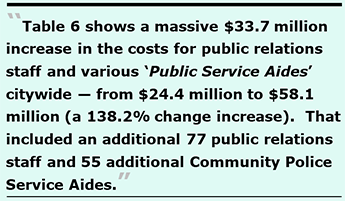 Table 6 shows a massive $33.7 million increase in the costs for P.R. staff and various “Public Service Aides” citywide — from $24.4 million to $58.1 million (a 138.2 change increase) between FY 10–11 and FY 23–24.
Table 6 shows a massive $33.7 million increase in the costs for P.R. staff and various “Public Service Aides” citywide — from $24.4 million to $58.1 million (a 138.2 change increase) between FY 10–11 and FY 23–24.
Unfortunately City Departments frequently use other job classification codes to disguise their true number of P.R. staff. For instance, the Department of Emergency Managements (DEM) counts among its six Public Relations staff one job code 0941 Manager VI with a working job title of “Chief of Staff,” and one job code 0923 Manager II with a working job title of “External Affairs Manager.” Between the two positions, DEM adds another $414,809 in total pay to the costs of its additional four job code 1314 Public Relations Officers at a cost of $380,341. Combined, the six Public Relations staff cost DEM $705,150 in total pay (excluding fringe benefits). It’s unknown how many padded P.R. staff are spread out in other City Departments using alternative job classification codes at higher pay.
Mayor’s Office Expansion
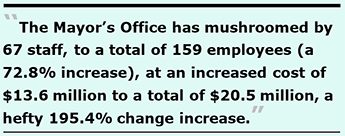 Table 7 shows that between FY 10–11 and FY 23–24 the Mayor’s Office has mushroomed by 67 staff, to a total of 159 employees (a 72.8% increase), at an increased cost of $13.6 million to a total of $20.5 million, a hefty 195.4% change increase.
Table 7 shows that between FY 10–11 and FY 23–24 the Mayor’s Office has mushroomed by 67 staff, to a total of 159 employees (a 72.8% increase), at an increased cost of $13.6 million to a total of $20.5 million, a hefty 195.4% change increase.
The increase involved 25 additional Mayoral Staff, plus 42 Community Development staff that more than doubled to 82, presumably in the Mayor’s Office of housing and Community Development (MOHCD). Although voters have passed several Affordable Housing Bond measures since FY 10–11, it’s not known why MOHCD needed to double in size, since obviously the City has not doubled the number of housing projects in its housing portfolio pipeline, as earlier projects have been completed and closed out.
Department of Public Health Bloat
Table 8 also shows at the top, a granular breakout by job classification code of the 138 additional Senior Managers at SFDPH included previously in Table 3 (Senior Managers by City Department). They’re repeated in Table 8 (but not double-counted in the number of total Senior Managers headcount and costs included in Table 1) for convenience.
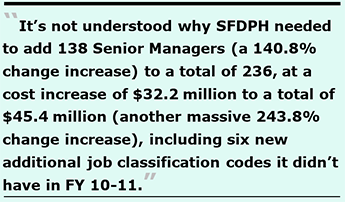 It’s not understood why SFDPH needed to add 138 Senior Managers (a 140.8% change increase) to a total of 236, at a cost increase of $32.2 million to a total of $45.4 million (another massive 243.8% change increase), including six new additional job classification codes with 23 additional employees that it didn’t have in FY 10-11, at an increased cost of $7.3 million. It’s thought many of the 23 additional employees in the six new job classification codes are new hires in SFDPH’s “San Francisco Health Network” (SFHN) first created in 2013 to 2014. We don’t know yet how many total employees are in the decade-old SFHN new division, or at what total additional cost.
It’s not understood why SFDPH needed to add 138 Senior Managers (a 140.8% change increase) to a total of 236, at a cost increase of $32.2 million to a total of $45.4 million (another massive 243.8% change increase), including six new additional job classification codes with 23 additional employees that it didn’t have in FY 10-11, at an increased cost of $7.3 million. It’s thought many of the 23 additional employees in the six new job classification codes are new hires in SFDPH’s “San Francisco Health Network” (SFHN) first created in 2013 to 2014. We don’t know yet how many total employees are in the decade-old SFHN new division, or at what total additional cost.
Primarily, Table 8 illustrates:
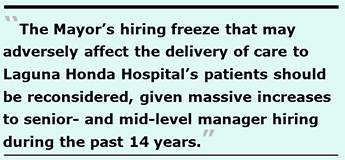 It’s not known if Mayor Lurie’s hiring freeze also mandated that there be no “promotion” or “TX-ing” (transfers) of employees from one job classification code to another job class code,
It’s not known if Mayor Lurie’s hiring freeze also mandated that there be no “promotion” or “TX-ing” (transfers) of employees from one job classification code to another job class code,
What is clear is that the Mayor’s hiring freeze that may adversely affect the delivery of care to Laguna Honda Hospital’s patients should be reconsidered, given the massive increases to senior- and mid-level manager hiring during the past 14 years. Nor should direct patient care to LHH’s residents suffer as a result of the hiring of Mayor Lurie’s four new “policy chiefs.”
Monette-Shaw is a columnist for San Francisco’s Westside Observer newspaper, and a member of the California First Amendment Coalition (FAC) and the ACLU. He is a Childless (and catless) Cat Daddy, and voter for 50 years. He operates stopLHHdownsize.com. Contact him at monette-shaw@westsideobserver.com.